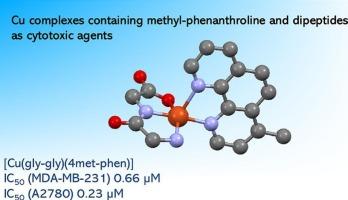新的含甲基-菲罗啉和二肽的铜配合物作为细胞毒剂。合成,表征和体外研究
IF 3.2
2区 化学
Q2 BIOCHEMISTRY & MOLECULAR BIOLOGY
引用次数: 0
摘要
与癌症相关的高发病率和死亡率表明需要新的治疗药物。金属基配位化合物提供了一个多样化的分子库,可以开发成药物,超出目前临床使用的那些。其中,铜配合物正在成为治疗癌症的有希望的候选者。本研究合成了一系列配合物[Cu(l-二肽)(met-phen)](其中met-phen: 4-甲基-1,10-菲罗啉和5-甲基-1,10-菲罗啉)并对其进行了表征。固态表征包括测定[Cu(Gly-Gly)(4met-phen)]·5.5 H2O和[Cu(phee -ala)(4met-phen)]·3H2O的晶体结构。通过固有结合常数(Kb)和相对粘度测量来评估DNA结合,表明部分插入到小牛胸腺DNA中。得到的Kb值大约比报道的与邻菲罗啉类似的配合物低十倍。这些复合物对一组人类癌细胞系的细胞毒性进行了评估:转移性乳腺腺癌MDA-MB-231(三阴性,ATCC: HTB-26),肺上皮癌A549 (ATCC: CCL-185),卵巢癌A2780 (ECACC 93112519)和非肿瘤肺细胞系MRC-5 (ATCC: CCL-171)。该配合物表现出强大的细胞毒性,IC₅0值在低微摩尔范围内,明显比顺铂更有效。[Cu(ala-gly)(5met-phen)]抑制克隆性集落形成并诱导其IC₅0以上的细胞死亡。这些发现表明,[Cu(l -二肽)(met-phen)]复合物是进一步体内研究的有趣候选者。本文章由计算机程序翻译,如有差异,请以英文原文为准。

New Cu complexes containing methyl-phenanthroline and dipeptides as cytotoxic agents. Synthesis, characterization and in vitro studies
The high incidence and mortality associated with cancer evidence the need for novel therapeutic agents. Metal-based coordination compounds offer a diverse arsenal of molecules that can be developed into drugs, beyond those currently in clinical use. Among them, copper complexes are emerging as promising candidates for cancer treatment. In this study, a series of complexes [Cu(L-dipeptide)(met-phen)] (where met-phen: 4-methyl-1,10-phenanthroline and 5-methyl-1,10-phenanthroline) were synthesized and characterized. Solid-state characterization included the determination of the crystal structures of [Cu(Gly-Gly)(4met-phen)]·5.5 H2O and [Cu(phe-ala)(4met-phen)]·3H2O. DNA binding was assessed through the intrinsic binding constant (Kb) and relative viscosity measurements, indicating partial intercalation into calf-thymus DNA. The obtained Kb values were approximately tenfold lower than those reported for analogous complexes with phenanthroline. The cytotoxicity of the complexes was evaluated against a panel of human cancer cell lines: metastatic breast adenocarcinoma MDA-MB-231 (triple negative, ATCC: HTB-26), lung epithelial carcinoma A549 (ATCC: CCL-185), ovarian carcinoma A2780 (ECACC 93112519), and nontumoral lung cell line MRC-5 (ATCC: CCL-171). The complexes exhibited potent cytotoxicity, with IC₅₀ values in the low micromolar range, which was significantly more effective than that of cisplatin. [Cu(ala-gly)(5met-phen)] inhibits clonogenic colony formation and induces cellular death above its IC₅₀. These findings evidence that [Cu(L-dipeptide)(met-phen)] complexes are interesting candidates for further in vivo investigation.
求助全文
通过发布文献求助,成功后即可免费获取论文全文。
去求助
来源期刊

Journal of Inorganic Biochemistry
生物-生化与分子生物学
CiteScore
7.00
自引率
10.30%
发文量
336
审稿时长
41 days
期刊介绍:
The Journal of Inorganic Biochemistry is an established international forum for research in all aspects of Biological Inorganic Chemistry. Original papers of a high scientific level are published in the form of Articles (full length papers), Short Communications, Focused Reviews and Bioinorganic Methods. Topics include: the chemistry, structure and function of metalloenzymes; the interaction of inorganic ions and molecules with proteins and nucleic acids; the synthesis and properties of coordination complexes of biological interest including both structural and functional model systems; the function of metal- containing systems in the regulation of gene expression; the role of metals in medicine; the application of spectroscopic methods to determine the structure of metallobiomolecules; the preparation and characterization of metal-based biomaterials; and related systems. The emphasis of the Journal is on the structure and mechanism of action of metallobiomolecules.
 求助内容:
求助内容: 应助结果提醒方式:
应助结果提醒方式:


